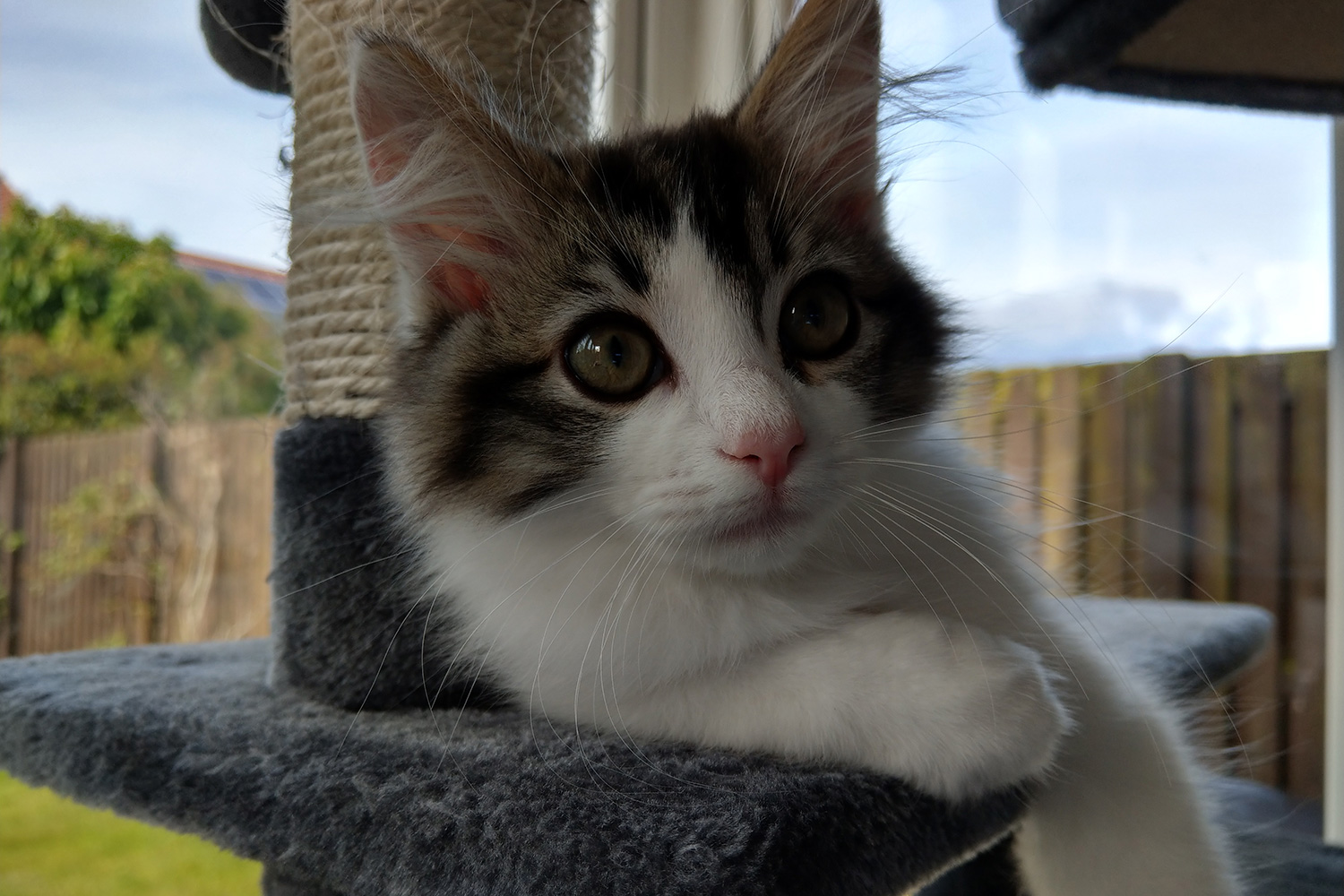- Great camera
- Alexa support
- Slick performance
- Good battery life
- No 3.5mm audio jack
- Bulky body
After the disappointing, incremental updates of the One M8 and M9, last year’s HTC 10 showed that the Taiwanese company still has ambitions in the smartphone market. The phone was deservedly popular with reviewers, but sadly failed to ignite public excitement.
This year’s HTC U11 is a much more dramatic departure from past flagships like the HTC 10, switching brushed aluminum for an eye-catching liquid-glass finish wrapped around a powerful, squeezable smartphone that offers tempting features. We think it’s excellent competition against flagships like the LG G6 and the Samsung Galaxy S8 thanks to a stellar camera, and fluid performance. Let’s dive in.
Beautiful, but big
The most noticeable feature of the HTC U11 is its liquid-glass surface. The U11 is one of the shiniest phones we’ve ever handled, and you really do need to see it in person to get an idea of how the refractive minerals baked into the glass change color as you tilt the phone. The eye-catching red U11 changes to gold, the white shows all the colors of the rainbow, and the black has a subtle hint of green. Our silver review unit is more of a light blue, but there is also a darker blue option.
HTC’s glass doesn’t just look good, it also curves slightly –on the front and back — to seamlessly blend into an aluminum frame. It’s very comfortable to hold, and the rear finish feels more like plastic in the hand than glass, because it warms to the touch quickly. The immediately obvious downside to an almost mirrored back is that it picks up grubby fingerprints and smudges. If you want to maintain its good looks, carry a microfiber cloth in your pocket, and be prepared to polish.
The next most visible feature is the U11’s size — this phone is big. The U11 has a 5.5-inch display, but the front has a spacious edges above and below. Even compared to last year’s Samsung Galaxy S7 Edge, which also has a 5.5-inch display, the U11 feels big. Put it next to the impossibly slim Galaxy S8, which packs a larger 5.8-inch display, and the U11 feels monstrous.
It would be fair to say that HTC is not yet onboard with the bezel-less trend, or the new, longer 18:9 screen format that LG introduced with the G6. This could be a difficult obstacle for HTC to overcome, because, unlike Samsung and LG, the company does not have its own display division. From the front, the U11 looks undeniably dated and the S8 and G6 are much easier to manage one-handed
The HTC U11 has a Super LCD 5 screen with a resolution of 2560 x 1440 pixels, which offers a sharp 590 pixels-per-inch. It’s comfortable to read on for long periods, and games and movies look good. The brightness is limited, however, which can be a problem in direct sunlight.
The HTC U11 is silky smooth and lightning fast.
It’s debatable how important the elongated screen and tiny bezels are, but the lack of anything special in this department is certainly a weak point for the U11.
Below the screen there’s a recessed, glass fingerprint sensor. It’s usually fast and responsive, but we did find that it was triggered by our palm accidentally, more often than we’d have liked, and it occasionally took a couple of tries to unlock. The fingerprint sensor is flanked by capacitive touch buttons for back and recent apps. They only light up when pressed and there’s vibration feedback.
Look at the bottom edge and you’ll see that HTC has also made the switch to USB Type-C. You won’t find a 3.5mm audio jack on this phone, but HTC has provided USB Type-C earphones and an adapter in the box.
Lightning fast
Using the HTC U11 is silky smooth and lightning fast. Navigating around, jumping in and out of apps, and gaming are hitch-free. That shouldn’t come as much of a surprise, considering the U11 is packing a Snapdragon 835 backed by 4GB of RAM.
We played Injustice 2, Super Mario Run, and Asphalt Extreme, and didn’t encounter any performance issues at all. This phone is a dream for gaming. The Snapdragon 835 is Qualcomm’s current top of the line and it offers significant performance and efficiency boosts over previous chips. It debuted in the Galaxy S8, but you won’t find it in many other phones just yet — a boon for HTC.
When we ran the benchmarks on our HTC U11, the scores were impressive:
- 3DMark SlingShot Extreme: 3,631
- AnTuTu: 175,748
- Geekbench 4: 1,926 single core; 6,493 multi core
For comparison, the S8 scored 2,052, 155,253, and 1,762 single core, 5,723 multi core in the same tests, respectively, whereas the G6 (which has the older Snapdragon 821) scored 2,102 in 3D Mark, and 135,032 in AnTuTu.
The vast majority of Android phones we’ve owned have exhibited some increased sluggishness over time, so we’ll be interested to see if the U11 slows down. Right now, it’s one of the fastest phones we’ve ever used, and it has more than enough power for most people.
If you’re wondering about storage, the base model offers an ample 64GB with room for expansion via a MicroSD card slot.
Squeeze me
One of the headline features for the HTC U11 is called Edge Sense and it allows you to squeeze the bottom edges of the handset to perform a variety of shortcuts, such as launching the camera, and snapping a photo. You can also configure it to launch Google Assistant or Amazon’s Alexa , turn on Wi-Fi or the flashlight, record your voice, or launch any other app of your choice. Since release HTC has updated the Edge Sense functionality further, so that you can squeeze to trigger actions within apps and games. This means it can be used to zoom in on Google Maps or make Mario jump in Super Mario Run.
It’s easy to set up and you’re prompted to try it out when you first turn on your U11. There are sensors running down each side of the phone that start below the power button. You can set the force you’re comfortable using, and vibration feedback as well as an onscreen animation will let you know it’s working. If you find you’re activating it accidentally, you can re-calibrate it to require more force.
If you enable advanced mode, you can set one action for a short squeeze and a different one for a squeeze and hold. This takes a little practice to master. By default, one squeeze will launch the camera and you can squeeze again to snap a photo. This may sound like a bit of a gimmick, but it’s actually a step forward towards a button-less phone design. HTC is trying to ease us gently into the idea with Edge Sense, and we expect further developments in this direction if it proves popular.
We had doubts about its usefulness to begin with, but there are situations where Edge Sense works nicely. The default camera launch is a quick shortcut and the ability to squeeze again to capture a photo, coupled with the reflective back, means you can easily use the rear camera for superior selfies. It also works when the U11’s screen, or your hands, are wet.
If you live somewhere cold and use gloves, then we can see Edge Sense coming in handy once more. It’s not an earth-shattering feature, but it’s interesting, and it’s nice to see HTC is still innovating. As smartphones lose the bezels and buttons, we are going to need new ways of interacting with them and squeezing feels like a natural gesture.
Android, Hands-free Alexa, and Sense UI
The HTC U11 runs Android 7.1.1 with the Sense user interface on top. It’s not too far away from stock Android, and it will be instantly accessible for anyone who has used Android before. HTC is mostly content to employ Google’s suite of apps instead of doubling up with inferior versions of its own, as some Android manufacturers unfortunately still insist on doing.
The HTC U11 has the distinction of being the first phone with hands-free Amazon Alexa support. It’s not the only phone with Alexa, as Huawei rolled out Alexa support on the Mate 9 at the end of March. But the U11’s Snapdragon 835 processor supports activation of two hands-free services at the same time.
The Alexa app, like Alexa on the Huawei Mate 9, doesn’t show visuals like the Amazon’s Echo Show speaker. But it can do almost everything else Alexa can do on Amazon’s Echo speakers, including smart home control, weather reports, news, traffic, alarms, calendar support, and plenty more. It also has access to Amazon’s collection of 10,000 skills in the Alexa store.
AI helpers are often of dubious helpfulness, but much depends on what you expect. Alexa worked quite well on the U11 — even from the phone’s lockscreen. It answered trivia questions, gave us the weather report, and gave us local commute times.
Sense Companion is better than expected, but it’s not a reason to buy the phone.
Then there’s HTC’s Sense Companion. It’s another AI assistant (which debuted on the HTC U Ultra), but don’t worry, because you can still long press the fingerprint sensor to launch Google Assistant. Sense Companion doesn’t compete as a voice assistant — it’s like a layer on your smartphone that learns by snooping on your activity (if you choose to allow it), and then offers up suggestions you might like.
The Sense Companion served up useful contextual suggestions. It reminded us to dress for rain when it was wet, it optimized a few apps to boost battery life, and it recommended some nearby eateries for lunch. It also tracks your activity, providing a weekly step count report, highlights points of interest when you’re out and about, and gives you traffic updates that might impact your commute.
It’s more useful than Google Now with preemptive suggestions, because it pops up over apps as a Facebook Messenger-like chat head. It’s better than expected, but it’s not a reason to buy the phone.
Plenty of stamina
With a battery capacity of 3,000mAh — the same size as the battery in the Galaxy S8 — we expected standard day-long performance, but we’ve been pleasantly surprised. The HTC U11 has no trouble lasting past bedtime, even with heavy use.
Much depends on which apps and games you use, signal strength in your area, and a few other factors, but the U11 seems to have good battery life. On average, it lasts more than a day — we ended a day of average use with about 40 percent remaining.
Speaking of charging, the U11 supports Qualcomm’s Quick Charge 3.0 technology. It juices up fast when the battery is low, but then slows down as it approaches capacity. To give an example, this morning it took half an hour to go from 22 percent to 69 percent, but another hour to reach 100 percent.
We’re a little disappointed that there’s no support for wireless charging, like you’ll find in the S8.
Camera is a contender
Everyone wants a great camera in their smartphone, but it has not been a strong point for HTC over the last few years. That may all be about to change with the U11. This is an excellent camera that gets consistently good results in a variety of different environments and conditions. We’ve really enjoyed our time with it so far.
Early indications that HTC might have got the camera right came from news that DxO Mark awarded it a score of 90, the highest score it has ever given a smartphone camera. For reference, the Google Pixel scored 89, the Galaxy S8 scored 88. and the iPhone 7 scored 86.
The HTC U11 has a 12-megapixel main camera with a large f/1.7 aperture, with Optical Image Stabilization, a dual LED flash, and HDR Boost. Photographers will appreciate the Pro mode with RAW format support.
During our testing in auto mode, we found quickly pointing and shooting with the U11 camera resulted in pleasingly great shots more often than not. It’s very fast to focus, captures a real depth of detail with very little noise, and the colors are vibrant, but realistic.
In sunny conditions, most photos turned out great, and low-light performance is equally impressive. There’s inevitably some blooming with bright lights, but the U11 compares favorably with other smartphone cameras. It’s great for close-ups, too, capturing microscopic details with a solid bokeh effect blurring the background.
The front-facing camera is rated at 16 megapixels with an f/2.0 aperture, HDR Boost support, and 1080p video recording. It’s ideal for video calls and capable of capturing detailed selfies, although we preferred the results when we used the squeeze function to snap selfies with the main camera.
Wired for sound
We were glad to find BoomSound speakers in the HTC U11, though the main speaker is bottom facing — we occasionally had to readjust our fingers to avoid covering it up. The volume and quality is good — for a phone – in fact, it’s one of the loudest phones we’ve ever tested. Call quality and clarity is also solid.
The U11 comes with a pair of fairly comfortable USonic earphones with active noise cancellation in the box with your U11. We were really impressed with the noise cancellation. When music plays, it drowns out the vast majority of background sound from your environment. Movies and TV shows are a lot more immersive with the earphones, too.
Our Take
We’re conflicted on the HTC U11 design. The liquid glass finish is gorgeous and the build quality is generally high, but fingerprint smudges quickly spoil it. The U11 also feels big, with an average display that has too much border around it.
Under the hood, the U11 offers unsurpassed speed and fluidity. The camera is one of the best we’ve used, the audio quality is above average, and we’re satisfied with the battery life. Squeezability is in its infancy, but it’s useful at times and points the way to a possible button-free future.
Price, availability, and warranty
You can order the HTC U11 unlocked from HTC or Amazon for $650, or pick it up from Sprint on a two-year contract at $29 per month. It’s now shipping to customers in the United States. In the U.K., it’s also sold through HTC’s own online store, through the EE network, or Carphone Warehouse for 650 British pounds.
There are four available colors: black, silver grey, blue, and red. The stunning solar red — the liquid glass surface switches from red to orange depending on the light — is our particular favorite, and the excellent news is it can be purchased in both the U.S and the United Kingdom.
The HTC U11 comes with a standard limited 2-year warranty that covers manufacturing defects and faulty parts or components, but not accidents. The phone is IP67-rated, which is good because you’re not covered for water damage. Sadly, the U11 is not covered by HTC’s Uh-Oh Protection, which offers a free replacement for cracked screens or water damage when you buy your phone directly from HTC.
HTC is also currently running a limited-time promotion for U.S. subscribers through the end of September. If you purchase an HTC 11, you’ll receive three months of Amazon Music Unlimited for free.
Is there a better alternative?
The most popular Android smartphone right now is the Samsung Galaxy S8 and there’s little doubt it outclasses the U11 in the style department, but it will cost you at least $100 more. The identically priced LG G6 is an even closer competitor. It’s not as powerful as the U11, but it has a great wide-angle lens and that new 18:9 screen format.
The OnePlus 5 offers Snapdragon 835 power for a lower $480 price, then throws in up to 8GB of RAM for good measure, along with a capable dual-lens camera. The design is attractive, but the color choice is dull compared to the eye-catching HTC U11.
How long will it last?
The HTC U11 should comfortably last you two years, maybe three. It has the latest flavor of Android with Google Assistant onboard, and HTC’s president of smartphones, Chialin Chang, has confirmed that the handset will be updated with at least the next two major Android versions.
It also has the cutting-edge Snapdragon 835 inside, which is Qualcomm’s top chip right now. Based on our testing the U11 is powerful enough to satisfy your every whim for the foreseeable future.
Should you buy it?
Yes. If you value substance over style, the HTC U11 is easy to recommend. It’s lightning fast, it delivers compelling audio quality, the camera gets excellent results with no fiddling required, and the battery life is solid. Sense Companion complements Google Assistant and Alexa nicely, and Edge Sense is the innovative cherry on top.
Update: We added details about the extended Edge Sense functionality.



























